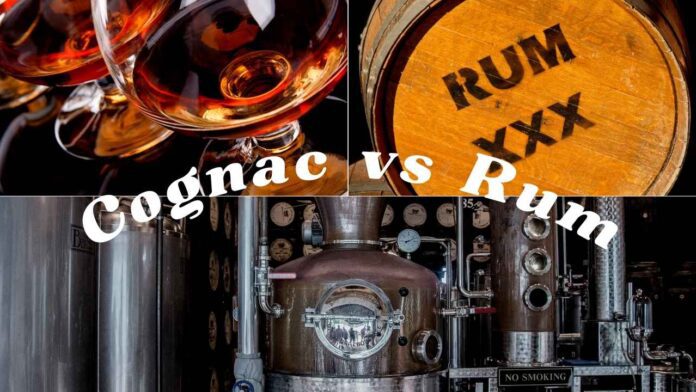This page may contain affiliate links. Please see our Disclaimer for more information. Always drink responsibly and adhere to your local legal drinking age.
Introduction
Cognac and rum, two different yet equally captivating spirits, have captivated the hearts of cocktail drinkers worldwide. Though they share some similarities in their rich heritage and aging processes, they boast unique flavors that set them apart.
From their production to flavor profiles and origins, join us on this fascinating journey as we explore the world of cognac vs. rum, gaining a deeper understanding of these beloved beverages so you can savor each sip with newfound appreciation.
Key Takeaways:
- Cognac and rum have distinct production processes and raw materials, resulting in different flavor profiles. Cognac is made from white grapes grown in the Cognac region of France, while rum originates from sugarcane byproducts like molasses or juice.
- Both cognac and rum undergo fermentation and distillation but differ in their aging techniques. Cognac must be aged in oak barrels for at least two years, while rum can be aged anywhere globally for varied lengths.
- The serving temperature can impact the taste profile of both spirits; cognac served slightly warmed pairs well with dark chocolate or nuts, while room temperature or chilled somewhat rum goes great with spiced dishes or tropical fruits.
- Moderate consumption of both cognac and rum could offer several health benefits, such as reducing heart disease risk, increasing good cholesterol levels (cognac), aiding weight management goals, and promoting relaxation/reducing stress levels (both).
Difference Between Cognac And Rum
The primary difference between cognac and rum is their distinct production processes and raw materials used. Cognac is a type of brandy produced exclusively in the Cognac region of southwestern France, using white grapes from specific vineyards within the designated area.
These grapes are then fermented into white wine, which undergoes double distillation in copper pot stills to create a clear spirit known as eaux de vie.
Rum, on the other hand, originates from sugarcane plantations across Latin America and the Caribbean islands. To produce rum, molasses or sugarcane juice is first fermented before undergoing distillation using either pot stills or column stills; these variations yield different flavors and textures depending on producer preferences.
Moreover, both cognac’s distinct aging process – regulated by stringent laws set up by the official Cognac Appellation d’Origine Contrôlée (AOC) –and unique ‘terroir’ conditions contribute to its elevated status among spirits connoisseurs worldwide, unlike rum, whose versatility allows for numerous regional styles with an array of tastes ranging from light-bodied whites to robust dark rums that could appeal broadly to cocktail drinkers alike.
Production Process And History
The production processes of Cognac and Rum have evolved over the centuries, shaping their unique characteristics and flavors. Originating in the 16th century, Cognac is a type of brandy exclusively produced in the Cognac region of southwestern France.
This elegant spirit is distilled twice using copper pot stills and aged for at least two years in French oak barrels, which imparts its nuanced complexity.
On the other hand, Rum’s rich history dates back to the 17th century when it was first produced in Caribbean sugar plantations as a byproduct of refining molasses or raw sugarcane juice fermenting.
As this spirited liquor gained popularity among sailors and pirates alike, its production spread across Latin America, where each island or country developed its distinct style incorporating different distillation methods – some use pot stills. In contrast, others employ column stills based on their desired flavor profiles.
Both spirits are prime examples of how craftsmanship intertwines with regional customs, creating iconic beverages that continue delighting connoisseurs worldwide today.
Raw Materials
The raw materials for Cognac and Rum production are vastly different, making them distinctive in flavor profiles and the overall character of each spirit. For Cognac, a type of brandy distilled from white wine, it all begins with grapes – specifically Ugni Blanc grapes grown in the Cognac region of southwestern France.
In contrast, Rum is a spirited liquor from sugarcane byproducts like molasses or sugarcane juice. Predominantly produced in Caribbean countries and Latin America, this sweet ingredient undergoes fermentation before being distilled into the strong drink we know today.
Cuba is particularly strict about using only Cuban-origin sugar cane products when producing their rum, ensuring an exact flavor profile characteristic of this tropical island nation.
Fermentation And Distillation
The production process for both Cognac and rum involves fermentation and distillation. During fermentation, yeast is added to grape juice or sugar cane byproducts to convert the sugar into alcohol.
Once fermented, the liquid is distilled in a copper pot to remove impurities and increase its alcohol content.
The wine must be double-distilled in copper pot stills in Cognac production before being placed into French oak casks for aging. In contrast, rum can be produced using a single or double distillation process depending on whether it’s considered “light” or “dark”.
Rum also has more flexibility in aging as it can be aged in new or used oak barrels, giving producers greater control over its flavor profile.
Aging
Aging is a crucial part of cognac and rum production, where the spirits develop their unique flavors and aromas over time. Cognac must be aged for at least two years, with some varieties spending decades in French oak casks before being bottled.
The longer it matures, the smoother and richer it becomes.
Different aging techniques like solera add complexity and character to various types of rum. This method involves removing a portion of the oldest rum from each barrel every year and blending them into new barrels containing younger rums.
Flavor Profile Differences: Comparing Cognac And Rum
Cognac has a smooth, rich flavor with notes of vanilla and oak, while rum has a sweeter taste with hints of caramel, molasses, and fruit.
Cognac Flavor Profile And Aroma
It is a distilled spirit made from the fermented juice of grapes harvested around Cognac, southwestern France. It has its unique aromas and flavors, which merge harmoniously within a blend to bring multiple sensory delights.
The base notes often contain earthy and smoky tones derived from French oak casks. Meanwhile, lighter fruit notes include apricot, peach, and other stone fruits punctuating the palate’s sweet spot.
Aromas like vanilla, caramelized sugar, hazelnut, cinnamon clove, or orange peel can also be detected throughout the blending process for that signature scent.
Rum Flavor Profile And Aroma
Rum, with its sweet, spicy, and fruity notes, is a versatile spirit that can be enjoyed in many ways. Rum’s flavor profile can range from light and floral to rich and full-bodied, depending on where it’s produced.
Generally speaking, white rums are lighter with less complexity than darker ones. Dark rums have aged more in oak barrels and developed deeper flavors such as caramel or vanilla.
Spiced rums often contain added spices like cinnamon or nutmeg, contributing to the drink’s characteristic aroma and flavor.
Serving Temperature And Pairing Suggestions
Cognac and Rum’s serving temperature can impact the flavor profile. Here are some suggestions for serving temperature and pairing options to enhance your experience:
1. Cognac
– Room temperature or slightly warmed (between 60-70°F), as it helps release its aromas.
– Pair with dark chocolate or nuts, complementing its nutty and woody flavors.
– Sip on its own or mix in cocktails like Sidecar, Sazerac, or French Connection.
2. Rum
– Served at room temperature or slightly chilled (around 50°F) to balance its sweetness and mellowness.
– Pair with spiced dishes or tropical fruits to enhance its fruity and spicy notes.
– Enjoy on its own or mix in classic cocktails like Daiquiri, Mojito, or Piña Colada.
By experimenting with different temperatures and pairings, you can fully appreciate the unique flavors of Cognac and Rum.
Cognac Vs Rum
Both cognac and rum undergo a fermentation process before being distilled, but while cognac is made from fermented grape juice, rum is made from fermented sugarcane byproducts.
Aging Process
Cognac and Rum are both aged spirits, but their aging processes differ. Cognac must be aged in oak barrels from the Limousin or Tronçais forests for at least two years, while rum can be aged anywhere in the world, with some rums being matured for up to 25 years.
During the aging process, Cognac develops its signature flavor profile, decreasing the alcohol dryness sensation and developing color while producing a crystal clear spirit.
On the other hand, rum aging results in a golden or amber hue in the spirit cultivated naturally from casks that it was made in over time.
Both these spirits owe their unique flavors and aromas to this aging process and storage techniques employed by different brands around the world based on traditional best practices passed down over centuries giving us a vast array of options when selecting our favorite drinks!
Types Of Rum And Cognac Available
Various types of rum and cognac are available, each with its unique flavor and aroma profiles. Here are some of the most popular ones:
1. VS (Very Special) – aged for a minimum of two years
2. VSOP (Very Superior Old Pale) – aged for a minimum of four years
3. XO (Extra Old) – aged for a minimum of six years, but usually much longer
For rum:
1. White or Light Rum – clear and typically used in cocktails and mixed drinks
2. Gold or Amber Rum – aged for several years, giving it a golden color and a more complex flavor profile
3. Dark Rum – aged longer than gold rum, giving it its dark color and strong molasses taste
4. Spiced Rum – infused with spices like cinnamon and nutmeg for an added kick of flavor.
Additional types include Rhum Agricole, which is made from fresh sugar cane juice instead of molasses, and Single Estate Rums which come from specific distilleries or regions.
No matter what type you choose, cognac and rum offer a range of options to suit anyone’s preferences and taste buds.
Health Benefits Of Cognac And Rum
Cognac and rum offer various health benefits when consumed in moderation, thanks to their antioxidant properties and other nutrients. The table below outlines some of the notable health benefits of these two popular spirits.
| Health Benefits | Cognac | Rum |
|---|---|---|
| Antioxidant Properties | Rich in antioxidants, notably polyphenols, which help neutralize harmful free radicals. | It contains antioxidants, although at lower levels than cognac, that provide some protection against free radicals. |
| Heart Health | Consumed in moderation, cognac may help reduce the risk of heart disease and stroke risk by increasing good cholesterol (HDL) levels. | Some studies suggest moderate rum consumption may also benefit heart health by improving cholesterol levels. |
| Weight Management | Cognac is a low-calorie spirit, which can be a better choice for those watching their calorie intake. | Rum is also relatively low in calories, making it a suitable option for individuals on a weight management plan. |
| Blood Sugar Control | As a distilled spirit, cognac contains no carbohydrates or sugars, making it a suitable option for those with diabetes or watching their sugar intake. | Like cognac, rum is also a distilled spirit with no carbohydrates or sugars, making it a viable choice for individuals with diabetes. |
| Stress Reduction | When consumed in moderation, cognac may help promote relaxation and reduce stress. | Rum, when enjoyed responsibly, can also provide similar stress-reducing effects. |
Remember that excessive alcohol consumption can lead to various health problems, so it is essential to enjoy cognac and rum responsibly and within the recommended guidelines.
How To Enjoy Cognac And Rum
Enjoy cognac and rum by sipping it neat in a snifter glass to appreciate the flavors and aromas, or mix it into cocktails for a different experience.
Sipping And Neat
Drinking Cognac and Rum neat is an excellent way to experience the full flavor profile of these spirits. Sipping allows you to taste each individual note in the drink, appreciate its complexities, and pick up on subtle hints of fruitiness or spiciness.
Pouring a measure into a snifter glass will help capture all the aromas that typically float away when served in other glasses.
When sipping Cognac, it’s worth remembering that unlike Whiskey, which can be overwhelmingly smoky or peaty, Cognac has more fruity notes such as apricot, pear, and apple.
It’s often enjoyed by fans who appreciate complex flavors like honeyed sweetness, floral undertones, and an oaky finish at room temperature.
Mixing In Cocktails
Mixing cognac and rum in cocktails can create some of the tastiest drinks. Here are some tips for using these spirits in your next cocktail creation:
1. Consider the flavors of each spirit before mixing them. Cognac has a more complex, fruity flavor profile, while rum tends to be sweeter and more assertive.
2. Use high-quality ingredients like fresh-squeezed juices, homemade syrups, and bitters to complement the flavors of cognac and rum.
3. Try classic combinations like a Sidecar (cognac, triple sec, lemon juice), Daiquiri (rum, lime juice, simple syrup), or Mai Tai (rum, lime juice, orange curaçao).
4. Experiment with different ratios of cognac and rum to find your preferred balance of flavors.
5. Don’t forget about garnishes! Citrus peels and fresh herbs can add an extra layer of complexity to your cocktails.
6. Avoid over-mixing or shaking too vigorously to prevent dilution or splitting of the liquors.
7. Serve in appropriate glassware such as a coupe for lighter, fruitier cocktails or a rocks glass for those with a more robust flavor profile.
By following these tips, you can create delicious and unique cocktails that showcase the flavors of both cognac and rum. Cocktail aficionados know that understanding the differences between different types of distilled spirits can help create better-mixed drinks – so why not try?
Food Pairing Suggestions
When it comes to enjoying cognac and rum, pairing them with food can enhance the experience. Here are some food pairing suggestions for cocktail drinkers:
1. Cognac:
– Aged or vintage cognacs pair well with strong, creamy cheeses such as Roquefort or Comté.
– Pair younger and more floral cognacs with light appetizers such as smoked salmon.
– Dark chocolate or chocolate desserts are a perfect match for any cognac.
2. Rum:
– Pair aged rums with steak, which brings out the flavors of caramel and vanilla in the rum.
– White rums pair well with club soda or tonic water, making them perfect for summer cocktails.
– For a tropical twist, serve rum-based cocktails with ceviche or pineapple juice.
Whether you prefer cognac or rum, there is always a perfect food pairing to complement your drink of choice. So experiment and enjoy!
Which One To Choose: Rum Or Cognac?
Consider personal preferences and the occasion when deciding between rum or cognac. If you prefer sweeter drinks, rum may be a better choice; however, if you enjoy bold flavors and aromas, go for cognac.
Personal Preferences And Taste
Choosing between rum and cognac ultimately comes down to personal preferences and taste. Some people may prefer the sweeter, fruity notes of rum, while others may enjoy the rich, complex cognac flavors.
For example, if you like tropical drinks with a hint of sweetness, a white rum-based cocktail might be your go-to drink. On the other hand, if you appreciate more sophisticated tastes, such as oak-aged whiskey or scotch, then aged cognac may be more up your alley.
Occasion And Mood
Choosing between cognac and rum often depends on the occasion and your mood. Cognac is a sophisticated and refined drink typically enjoyed in the evening as an after-dinner drink paired with cigars.
On the other hand, rum is more versatile in its uses and can be mixed into cocktails for laid-back gatherings with friends or enjoyed straight on a warm summer day by the beach.
Ultimately, choosing cognac or rum depends on your preferences and the specific occasion. If you want to cozy up by the fire at night, then cognac might be just what you need.
Availability And Price
The availability and price of cognac and rum can vary depending on where you live. In some areas, they may be similarly priced, while in others, one may be significantly more expensive.
For example, in control states like Pennsylvania and Ohio, the mean prices of both liquors are relatively similar.
It’s also worth noting that there are different tiers or grades of cognac based on their aging process that contribute to variations in price. While VS (Very Special) cognacs have been aged for at least two years, XO (Extra Old) cognacs have been aged for at least six years.
Similarly, rum can also be categorized based on its production method and age, contributing to pricing differences.
FAQ
Q: What is the difference between Cognac and Rum?
A: Cognac is a specific type of brandy distilled in the region around Cognac in France, while rum is a spirit made from fermented fruit juice, typically sugar cane. The main difference is the base ingredient used to make them.
Q: Is Cognac a type of Brandy?
A: Yes, Cognac is a type of brandy made in the Cognac region of France. Brandy is a spirit made from fermented fruit juice that is then distilled and aged in wooden barrels.
Q: What is the difference between Brandy and Cognac?
A: While Cognac is a specific type of brandy made in the Cognac region of France, brandy can be made anywhere in the world using different types of fruit juice. In terms of taste, Cognac is often smoother and more refined than other brandies.
Q: What makes Cognac unique?
A: Cognac is made using a specific type of grape called Ugni Blanc, which is grown exclusively in the region around Cognac. The brandy is then double distilled in copper pot stills and aged in French oak casks, giving it a distinct flavor and aroma.
Q: How is Cognac made?
A: Cognac is made by fermenting grape juice into a wine. The wine is then distilled twice in copper pot stills, producing a clear spirit that is aged in French oak casks for at least two years. The aging process gives Cognac its distinct flavor and aroma.
Q: What are the different types of Cognac?
A: There are several types of Cognac, including V.S., V.S.O.P., and X.O. V.S. stands for “very special” and is aged for a minimum of two years, V.S.O.P. stands for “very superior old pale” and is aged for a minimum of four years, and X.O. stands for “extra old” and is aged for a minimum of six years.
Q: What is the Charente region?
A: The Charente region is a region in southwestern France known for producing Cognac. The region is also known for producing other types of spirits, including Armagnac and different types of brandy.
Q: Can Rum be made from other types of fruit juice?
A: Yes, while most rums are made from sugar cane juice or molasses, they can also be made from other types of fruit juice, such as grapes or apples.
Q: What is the difference between Brandy and Whiskey?
A: Brandy is a spirit from fermented fruit juice, while whiskey is from fermented grain mash. The aging process for whiskey is also typically longer than that of brandy, giving it a more complex flavor profile.
Q: Is Hennessy a type of Cognac?
A: Hennessy is a type of Cognac produced by the Hennessy distillery located in the Cognac region of France. Hennessy is known for its high-quality Cognacs and is one of the most popular brands of Cognac in the world.
Conclusion
In conclusion, while cognac and rum are delicious brown liquors, they have distinct differences in production, aging, and flavor profiles. Cognac is a type of brandy that must be made in the Cognac region of France and aged for at least two years in oak barrels to achieve its signature smoothness.
Rum, on the other hand, is made from sugarcane byproducts like molasses and aged for varying lengths of time depending on the desired color and flavor profile. Whether you prefer sipping neat or mixing into cocktails, understanding the differences between these two classic spirits can help elevate your drinking experience.






